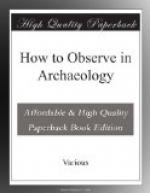Gold. Not uncommon. Copper nails with gold-plated heads (Shahrein).
Stone. Portrait figures in round (Bismaya, Telloh, &c.), usually representing men, with face and head shaven; very prominent large curved nose; usually squatting with arms crossed, sometimes standing; only garment a kilt apparently made of locks of natural wool. Usually inscribed in archaic characters on back of shoulders. Material: a grey or a white limestone most usual; tufa and dolerite also used. Reliefs: large stelae (Stele of the Vultures; Telloh, Louvre, fragment in B. M.), completely inscribed; small relief plaques, inscribed (Telloh, Louvre). Flint carved and engraved cylinder-seals, of limestone, black basalt, jasper, diorite, &c. Vases, bowls, and cups (usually fragmentary), of white and pink limestone and breccia. Maceheads of breccia, granite, &c., of same type as the early Egyptian (Shahrein).
Shell. Very largely used for decoration; small plaques of nacre often engraved with scenes of men worshipping, &c. (Telloh); tessellated pillars with nacre plaques (’Obeid). Seal-cylinders of shell.
Wood. Rarely survives; small beams plated with copper (’Obeid).
Burials. Pottery coffins with lids, mat burials; bodies contracted; funerary furniture, copper, stone or pottery drinking cups held near mouth: copper weapons, fish-hooks, net weights; beads of agate, lapis, shell (unpolished); colour-dishes, (Fara). (The idea that the Babylonians ever burnt their dead is now discredited; the supposed ‘fire-necropoles’ at Zurghul, &c., are not substantiated.)
The burials are hard to distinguish from similar contracted interments of later date, except that the furniture is more abundant in early times and mat graves are unusual in later days Mounds of this age may be known by the occurrence on the surface of scraps of oxydized copper, nails, &c.; shell-fragments; undecorated light drab sherds; and the typical small plano-convex bricks.
III. MIDDLE BRONZE AGE. 1. Early Semitic or Akkadian (Sargonid) period; c. 3000-2500 B.C.
Characteristics. Less crude style of art: development of writing (see XIV, Fig. 1); first inscribed clay tablets of usual style; beginnings of cuneiform, developed from the archaic semi-pictographic character. Bricks still plano-convex; stamped inscriptions begin. Stone maceheads of same type as earlier. Large and well-cut cylinder-seals of fine limestone, lapis, diorite, granite, and shell are characteristic of the period: they are generally of an easily recognizable form (reel-shaped) with sides showing a marked concavity (see XIV, Fig. 5). The great development of art is shown by the stele of Naram-Sin (Louvre) found at Susa. Not many mounds of this period have been dug.
2. Later Sumerian (Gudea) and early Semitic Babylonian (Hammurabi) periods; c. 2500-1800 B.C.




